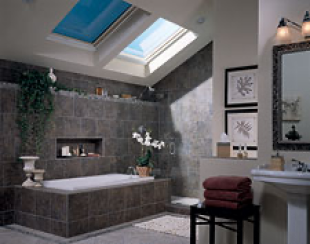
Window Technologies: Emerging Techniques-Dynamic Windows
The emerging concept for the window of the future is more as a multifunctional “appliance-in-the-wall” rather than simply a static piece of coated glass. These systems include switchable windows and shading systems that have variable optical and thermal properties that can be changed in response to climate and occupant preferences. By actively managing lighting and cooling, smart windows could reduce peak electric loads, increase daylighting benefits throughout the United States, improve comfort, and potentially enhance productivity in homes.
The ideal window would be one with optical properties that could readily adapt in response to changing climatic conditions or occupant preferences. There are two basic types of switchable windows—passive devices that respond directly to a single environmental variable such as light level or temperature, and active devices that can be directly controlled in response to any variable such as occupant preferences or heating and cooling system requirements. The main passive devices are photochromics and thermochromics; active devices include liquid crystal, suspended particle, and electrochromics.
Photochromics
Photochromic materials change their transparency in response to light intensity. Photochromic materials have been used in eyeglasses that change from clear in the dim indoor light to dark in the bright outdoors. Photochromics may be useful in conjunction with daylighting, allowing just enough light through for lighting purposes, while cutting out excess sunlight that creates glare and overloads the cooling system.
Thermochromics
Thermochromic materials for use in variable tinting windows can adapt to changing sunlight intensity to reduce heat load in buildings. Preferably the thermochromic layers in the windows change transmission continuously over a range of temperatures so they not only reduce heat loads (especially at times of peak demand), but they maximize daylighting. If properly designed, the thermochromic layers are minimally sensitive to changing outdoor or ambient temperatures but respond dramatically to changing amounts of direct sunlight on the windows. Sunlight responsive thermochromic windows use the sun’s energy to tint the windows and block the sun’s energy that otherwise would have ended up as heat load in the building. In addition to minimizing solar heat gain and maximizing daylighting, thermochromic layers help reduce glare, fading and noise, and increase safety. See www.commercialwindows.org for more information on thermochromic windows.
Electrochromics
The most promising switchable window technology today is electrochromic (EC) windows. The electrochromic thin film stack is deposited on a glass substrate and is typically about one micron thick. The stack consists of ceramic metal oxide coatings with three electrochomic layers sandwiched between two transparent electrical conductors. When a voltage is applied between the transparent electrical conductors, a distributed electrical field is set up. This field moves various coloration ions (most commonly lithium or hydrogen) reversibly between the ion storage film through the ion conductor (electrolyte) and into the electrochromic film. The effect is that the glazing switches between a clear and transparent blue-gray tinted state with no degradation in view, similar in appearance to photochromic sunglasses. See www.commercialwindows.org for more information on electrochromic windows.
Gasochromic Windows
Gasochromic windows produce a similar effect to electrochromic windows, but in order to color the window, diluted hydrogen (below the combustion limit of 3%) is introduced into the cavity in an insulated glass unit. Exposure to oxygen returns the window to its original transparent state. To maintain a particular state, the gap is simply isolated from further changes in gas content. The optically active component is a porous, columnar film of tungsten oxide, less than 1 micron thick. This eliminates the need for transparent electrodes or an ion-conducting layer. Variations in film thickness and hydrogen concentration can affect the depth and rate of coloration. See www.commercialwindows.or for more information on gasochromic windows.
Liquid Crystal Device
A variant of the liquid crystal display technology used in wristwatches is now serving as privacy glazing for new windows. A very thin layer of liquid crystals is sandwiched between two transparent electrical conductors on thin plastic films and the entire emulsion or package (called a PDLC or polymer dispersed liquid crystal device) is laminated between two layers of glass. When the power is off, the liquid crystals are in a random and unaligned state. They scatter light and the glass appears as a translucent layer, which obscures direct view and provides privacy. The material transmits most of the incident sunlight in a diffuse mode, thus its solar heat gain coefficient remains high. See www.commercialwindows.org for more information on liquid crystal technology.
Suspended Particle Device (SPD) Windows
This electrically controlled film utilizes a thin, liquid-like layer in which numerous microscopic particles are suspended. In its unpowered state the particles are randomly oriented and partially block sunlight transmission and view. Transparent electrical conductors allow an electric field to be applied to the dispersed particle film, aligning the particles and raising the transmittance. See www.commercialwindows.org for more information on suspended particle device technology.

Technologies, such as electrochromics, are now available for the residential market and commercial markets. The skylight on the left is switched to the “on” position—reducing glare and solar heat gain. The skylight on the right is switched to the “off” position. Photo: Velux-America and SAGE Electrochromics.